Your spring house size depends on your family's specific food storage needs and how much you'll store. For a single family, a small 8×8 foot structure works well for basic dairy and limited produce storage, while a medium 12×12 foot space suits multiple food purposes. If you're planning for multiple families or extensive storage, consider a large 16×16 foot or bigger spring house with separate rooms for different storage requirements. You'll need to maintain temperatures between 32-40°F and humidity levels of 80-90% for ideal preservation. Understanding your exact storage requirements will help you make the best size choice for your situation.
Assessing Your Food Storage Needs
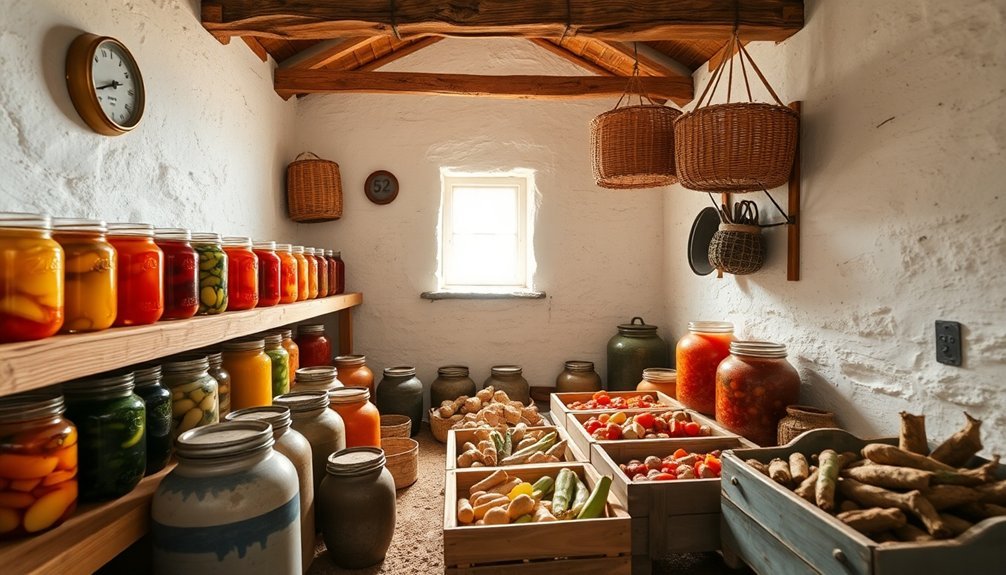
Three key factors determine the ideal size of your springhouse: the volume of food you'll store, the types of items you need to preserve, and how frequently you'll access them.
To properly assess your storage needs, you'll need to calculate the total quantity of food your household consumes between resupply periods.
Start by listing all the food types you'll store. For liquids like raw milk, you'll need space for multiple crocks or containers that can be partially submerged in spring water. If you're storing meat products, allocate dedicated areas where they'll receive consistent cooling.
For fruits and vegetables, consider their varying shelf lives and storage requirements – some may need more ventilation while others require deeper cooling. The stone trough system helps maintain consistently cool temperatures year-round.
Don't forget to account for the space needed between containers to maintain proper airflow and accessibility. You'll also need room for essential tools like gourd dippers and utensils.
If you're planning to store dairy products, verify there's enough space near the spring source where temperatures remain coldest.
Remember to include extra space for rotating stock and maintaining an organized storage system that allows easy access to frequently used items.
Understanding Spring House Cooling Methods
Natural spring water forms the cornerstone of spring house cooling, providing a remarkably consistent year-round temperature that's perfect for food preservation.
You'll find that this constant temperature helps protect your perishable items like meat and dairy from spoilage without requiring any artificial cooling methods. Sealing gaps and cracks is crucial for maintaining these stable temperatures.
The structural design of your spring house plays an essential role in its cooling effectiveness.
By building directly over a spring and properly enclosing it, you're creating a controlled environment that keeps out unwanted elements while maintaining cool temperatures.
You can enhance this natural cooling by taking advantage of surrounding shade and proper building orientation.
Your spring house's cooling performance depends heavily on insulation and ventilation management.
You'll want to guarantee proper insulation to prevent heat transfer from the outside while controlling ventilation to maintain ideal interior conditions.
This combination creates a stable climate that's perfect for food storage.
Before electric refrigeration, these natural cooling methods proved highly effective, particularly in cooler regions.
You'll appreciate how this time-tested approach still works today, offering an environmentally friendly alternative to modern cooling systems while preserving your food effectively.
Essential Space For Dairy Items
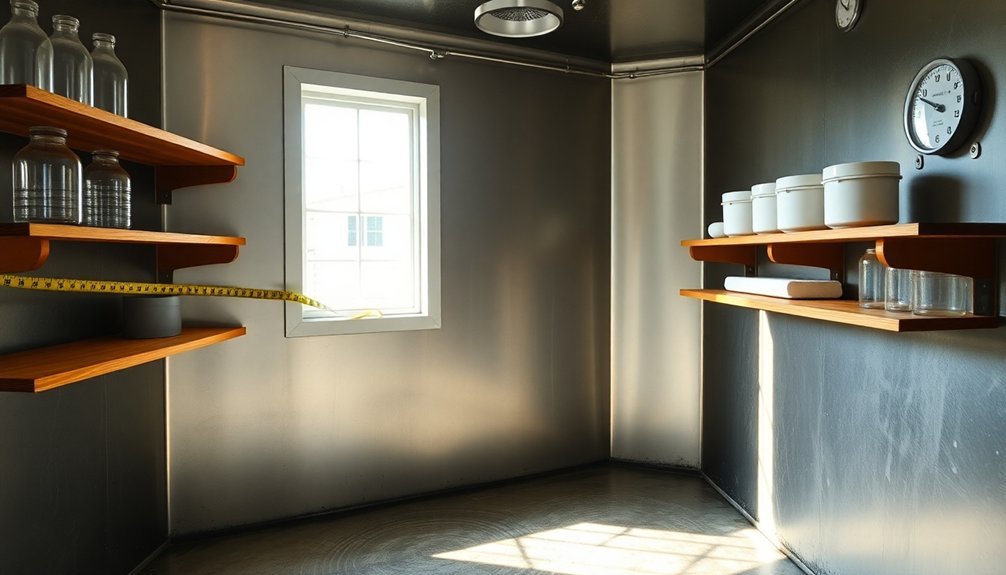
When planning your spring house layout for dairy storage, you'll need roughly the size of a single room to accommodate essential equipment and processing areas.
The space should efficiently handle your dairy processing needs while maintaining proper cooling through natural spring water or stream flow.
To maximize your dairy storage capacity, you'll want to incorporate built-in shelving along the walls and utilize vertical space with rafters for hanging milk pails.
Stone-lined channels or tanks should run along the interior to manage water flow and maintain consistent cooling temperatures.
A typical footprint of 7×9 feet minimum provides adequate space for a functional spring house setup.
Here's what you'll need space for in your dairy spring house:
- Multiple shelf levels for milk pans that allow cream to rise naturally
- Floor space for stoneware crocks containing butter and other dairy products
- Working area for churning and processing butter
- Storage area for essential dairy equipment and milk cans
If you're planning substantial butter production, consider adding a second story to your spring house.
This additional level can serve as extra storage space for dairy processing equipment or provide room for other preserved foods like pickled vegetables and cured meats.
Vegetable Storage Requirements
Proper vegetable storage in your spring house requires careful attention to temperature, humidity, and ventilation control.
You'll need to maintain temperatures between 32-40°F (0-4°C) for most root vegetables, while setting aside a slightly warmer area of 40-50°F (4-10°C) for potatoes and sweet potatoes.
To accommodate different vegetable needs, divide your spring house into separate zones. Create a high-humidity section (90-95%) for root vegetables like carrots and beets, and designate an area with moderate humidity for potatoes.
You'll want to install vents or small fans to guarantee proper air circulation and prevent mold growth.
Keep ethylene-sensitive vegetables like carrots, broccoli, and cauliflower away from fruits. Store most of your vegetables in perforated polyethylene bags, except for potatoes, cabbage, and cauliflower.
Don't wash produce before storage unless you can completely air-dry it first. For onions and potatoes, you'll need a warm, well-ventilated curing area before moving them to long-term storage.
Remember to check your stored vegetables regularly and remove any spoiled items to prevent rot from spreading to others.
Small Spring House Capacity
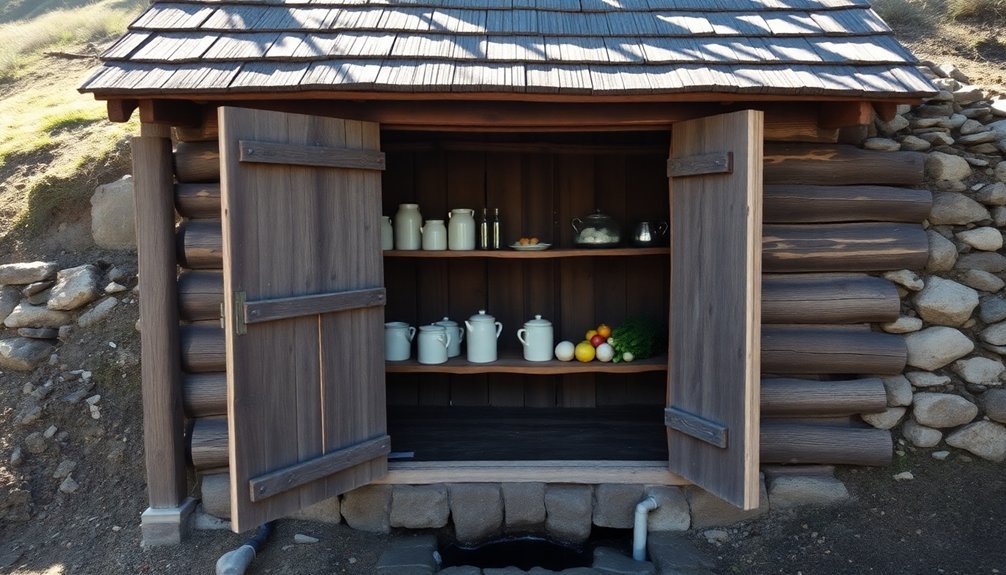
A typical small spring house offers storage capacity for up to several weeks' worth of perishable food items.
You'll find that even a modest-sized spring house can effectively store food for a family's needs when properly organized. The constant cool temperature provided by the spring water creates ideal conditions for preserving various perishables.
When planning your small spring house storage, consider these key capacity features:
- A single-room structure can accommodate dairy products like milk, butter, and cheese on elevated shelving.
- Floor-level stone troughs filled with spring water can keep meat products fresh for 1-2 weeks.
- Root vegetables and fruits can be stored in baskets or crates along the walls.
- Small pools created by the spring flow can hold containers of milk or other beverages.
You'll need to arrange items strategically to maximize your available space.
The spring house's effectiveness depends on proper air circulation and water flow, so avoid overcrowding.
While size varies, most small spring houses provide adequate storage for a family's weekly perishable needs while maintaining proper temperature and protecting food from animals.
Medium Spring House Benefits
Moving up from smaller structures, medium-sized spring houses offer expanded capabilities that greatly enhance your food storage options. With walls typically 1-2 feet thick, you'll get superior insulation that maintains consistent temperatures in the mid-50s°F year-round. You can store larger quantities of perishables while still benefiting from the natural cooling properties of spring water or creek proximity.
| Storage Type | Capacity | Preservation Method |
|---|---|---|
| Dairy | 4-6 milk pails | Hanging from rafters |
| Meat | 2-3 large joints | Air circulation |
| Root Vegetables | 8-10 bushels | Floor storage |
| Preserved Foods | 12-15 crocks | Shelf placement |
| Fresh Produce | 6-8 baskets | Elevated platforms |
You'll have enough space to serve multiple purposes, from storing dairy products to preserving vegetables. The medium size allows you to hang several milk pails from the rafters while maintaining floor space for root vegetables and shelving for preserved foods in stoneware crocks. This size is particularly efficient for families or small farms, providing ample room for food storage without sacrificing the spring house's natural cooling efficiency.
Large Spring House Features
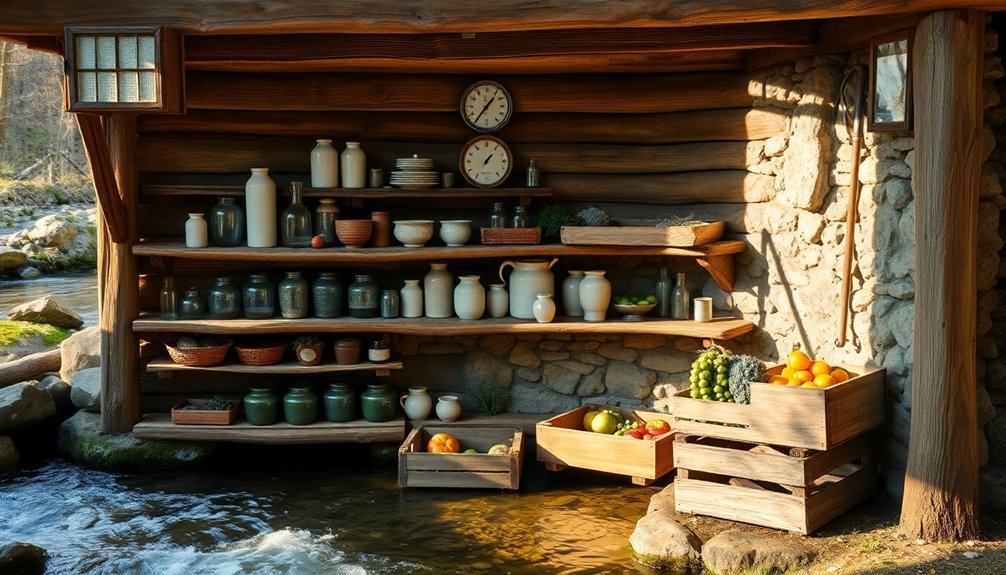
Large spring houses let you maximize food preservation with separate rooms for different storage needs and food preparation tasks.
You'll find dedicated spaces for hanging meats, storing dairy products, and keeping vegetables cool in their respective areas.
The multi-room layout helps you organize your food storage more efficiently while maintaining ideal temperatures for each type of preserved item.
Multi-Room Layout Advantages
Modern spring houses with multi-room layouts deliver significant advantages for homeowners seeking both privacy and flexibility.
You'll find these designs maximize space efficiency while providing separate areas for different activities and storage needs. The strategic placement of rooms creates natural zones that help maintain organization and improve functionality in your spring house.
Consider these key benefits of multi-room layouts in your spring house:
- You'll gain enhanced privacy with separated storage areas, allowing you to keep different food items in their best environments.
- You'll maximize space efficiency through thoughtful room placement, eliminating wasted hallway space while improving flow.
- You'll enjoy greater flexibility in how you use each room, adapting spaces as your storage needs change throughout the seasons.
- You'll benefit from improved accessibility with designated zones for different food preservation tasks.
The multi-room design also lets you incorporate features like temperature-controlled areas and specialized storage solutions.
You can customize each room according to specific preservation requirements, from root vegetables to preserved fruits.
With separate entries and distinct climate zones, you'll maintain ideal conditions for various food items while keeping everything organized and easily accessible.
Storage and Preparation Spaces
A well-designed spring house offers substantial storage and preparation areas that maximize your food preservation capabilities. You'll find thick stone walls, typically 1-2 feet wide, providing natural insulation that maintains temperatures in the mid-50s°F range. The interior features rafters for hanging milk pails and meat joints, while built-in shelves and floor spaces accommodate stoneware crocks filled with pickled goods.
| Space Type | Primary Features | Common Uses |
|---|---|---|
| Storage Area | Stone walls, built-in shelves, rafters | Meat hanging, dairy storage, preserved foods |
| Prep Zone | Limited counter space, vertical storage | Washing, cutting, food preparation |
| Water System | Internal channels, spring access | Temperature control, cleaning, preservation |
Your preparation area, while compact, offers dedicated spaces for different tasks. You'll benefit from the strategic design against a hillside, which enhances insulation and provides easy access to natural water sources. The water flow through small channels along the interior walls helps maintain consistent cooling temperatures. Despite limited horizontal space, you can efficiently utilize vertical storage with hanging implements and shelving systems, making the most of every square foot for your food preservation needs.
Seasonal Storage Considerations
You'll need to plan your spring house storage carefully for summer's peak demands when dairy and produce require consistent cooling in the mid-50°F range.
Your fall harvest planning should account for the different storage needs of fruits and vegetables, keeping them separated to prevent premature ripening.
During winter, you can maximize your preservation efforts by organizing items based on their temperature requirements and monitoring humidity levels to prevent both freezing and excess moisture.
Summer Peak Storage Needs
Planning for summer peak storage needs requires careful consideration of temperature control and space allocation. During the hottest months, you'll need to protect your food from extreme temperatures and maintain proper humidity levels to prevent spoilage. A properly sized spring house helps you manage these challenges effectively while accommodating your peak storage requirements.
Key considerations for your summer storage space include:
- Temperature zones of 32-60°F for different produce types, with specific areas maintained at distinct temperature ranges.
- Humidity control systems that can maintain 95% relative humidity for delicate vegetables like asparagus and broccoli.
- Separate storage areas for fruits and vegetables to prevent ethylene-induced ripening.
- Additional space for food-grade containers and proper packing materials.
You'll need to factor in extra space for air circulation and temperature monitoring equipment. Position your storage units away from heat sources and direct sunlight, using natural cooling features like basement locations when possible.
Remember to include enough room for organized rotation of stored items and maintain clear pathways for regular inspections. Consider installing additional cooling capacity during peak summer months to maintain ideal conditions.
Fall Harvest Planning
Building on effective summer storage practices, fall harvest planning brings a new set of challenges for your spring house size calculations. You'll need to carefully assess which produce you'll store and guarantee your spring house can accommodate the fall harvest volume while maintaining ideal conditions.
Start by selecting storage-friendly vegetables like root crops, winter squash, and hardy fruits. You'll want to focus on late-maturing varieties and only choose unblemished produce for long-term storage. Before storing, cure your potatoes, winter squash, onions, and pumpkins in a warm area to toughen their skins.
Your spring house should maintain temperatures between 32-60°F with proper ventilation. Plan your space to include shallow boxes for single-layer storage and areas for wrapped fruits. You'll need dedicated zones for vegetables that require different humidity levels.
Consider incorporating sand or sawdust beds for root vegetables like carrots and beets. When calculating space, factor in that different squash varieties have varying storage times – from two months for acorn to six months for butternut.
Remember to leave room for air circulation and guarantee your spring house design prevents standing water while protecting against pests.
Winter Food Preservation
Successfully preserving food through winter months requires careful attention to temperature and humidity control in your spring house.
You'll need to maintain temperatures between 32°F and 40°F while keeping humidity levels at 80-90% for most produce. Different foods demand specific conditions, so organize your storage space accordingly.
For ideal winter preservation, consider these essential guidelines:
- Keep root vegetables and apples in the coldest areas (32-35°F), while storing squash and sweet potatoes in slightly warmer zones (50-55°F).
- Maintain proper ventilation to prevent moisture buildup and spoilage, using natural airflow or small fans when necessary.
- Store onions and garlic in drier areas separate from moisture-loving vegetables to prevent premature sprouting.
- Use clean straw or wood shavings for insulation, creating layers between produce to prevent freezing and contact damage.
If your spring house can't accommodate all your winter storage needs, supplement with other preservation methods.
You can freeze blanched vegetables, dehydrate herbs and fruits, or use pressure canning for low-acid foods.
Remember to handle all produce carefully during harvest and storage to prevent damage that could lead to spoilage.
Meat Preservation Space Requirements
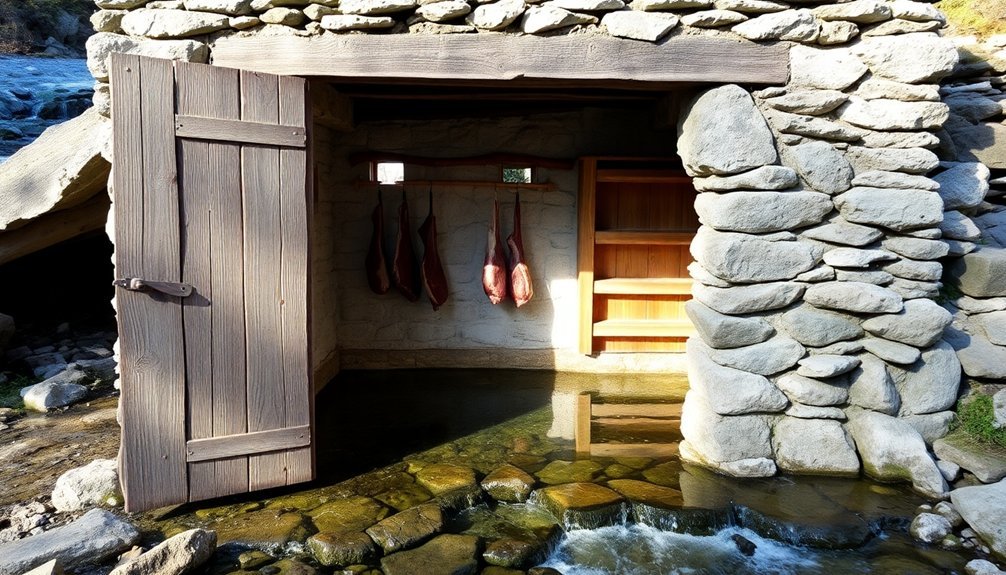
For effective meat preservation in a spring house, you'll need to allocate adequate space based on your family's consumption needs.
When planning your spring house dimensions, consider that meat storage requires stone troughs or earthenware containers large enough to keep portions partially submerged in cool spring water, maintaining temperatures between 10°C to 15°C.
You'll want to design your storage layout with easy access in mind, ensuring there's enough room to move around without disturbing other stored items.
Plan for stone shelving that can support the weight of multiple meat containers while allowing proper water circulation. If you're storing different types of meat, you'll need separate sections to prevent cross-contamination and maintain organization.
The key is to create sufficient space for both immediate-use portions and longer-term storage while maintaining proper humidity levels and limited air circulation.
Your spring house should include enough room for gourd dippers and other handling tools.
Calculate approximately 2-3 cubic feet of storage space per week's worth of meat for a family of four, adjusting this estimate based on your specific consumption patterns and the types of meat you'll be preserving.
Water Flow and Temperature Control
You'll need to monitor both water flow and temperature precisely in your spring house using a flow meter to measure gallons per minute and digital thermometers at inlet and outlet points.
Your flow rate should maintain 8 g.p.m. or less, with pressure between 40-250 psi for peak performance, while keeping temperatures between 35-100°F for safe food storage.
Regular checks of these measurements using calibrated instruments will help you maintain the ideal environment for food preservation and prevent issues like bacterial growth or inadequate cooling.
Flow Rate Assessment Methods
Managing your spring house's water flow begins with accurate flow rate assessment, which is essential for maintaining proper food storage conditions.
You'll need to choose the most appropriate measurement method based on your spring's size and characteristics to guarantee peak performance.
1. Velocity-area measurement works well for most spring houses, letting you use handheld meters to measure water speed across different sections of your inlet channel.
You'll combine these measurements to calculate total flow.
2. For smaller springs, you can use timed-volume methods by collecting water in a container of known size over a specific time period, or install a portable cutthroat flume for continuous monitoring.
3. If you're dealing with a larger spring, consider acoustic Doppler methods using ADV devices, which provide precise measurements by bouncing sound waves off particles in the water.
4. Stage-discharge relationships offer ongoing monitoring once established.
You'll need to create and maintain a rating curve, but this method provides reliable long-term data for your spring house operations.
Remember to periodically recalibrate your chosen measurement method, as natural changes in your spring's channel can affect flow patterns and measurement accuracy over time.
Temperature Monitoring Techniques
The key to maintaining ideal spring house conditions lies in proper temperature monitoring and control systems. You'll need to implement thermostatic control valves to maintain consistent water temperatures throughout your spring house. These valves work automatically by expanding and contracting based on water temperature, ensuring your stored food remains at optimal temperatures.
| Control Feature | Function | Benefit |
|---|---|---|
| Thermostatic Element | Expands with temperature changes | Maintains uniform temperatures |
| By-pass System | Manual or electric activation | Enables bacterial control |
| Installation Design | Simple setup and maintenance | Reduces operational issues |
For effective food storage, you'll want to incorporate both primary and secondary circulation loops. This setup helps eliminate temperature fluctuations that could compromise food quality. The valves reduce waiting time for temperature adjustments and prevent water waste, which is essential for spring house efficiency. You can manually adjust the by-pass features when you need to increase water temperature for sanitization purposes. The system's user-friendly design makes it easy to maintain and adjust settings as needed, ensuring your spring house maintains consistent temperatures year-round.
Multiple Family Storage Planning
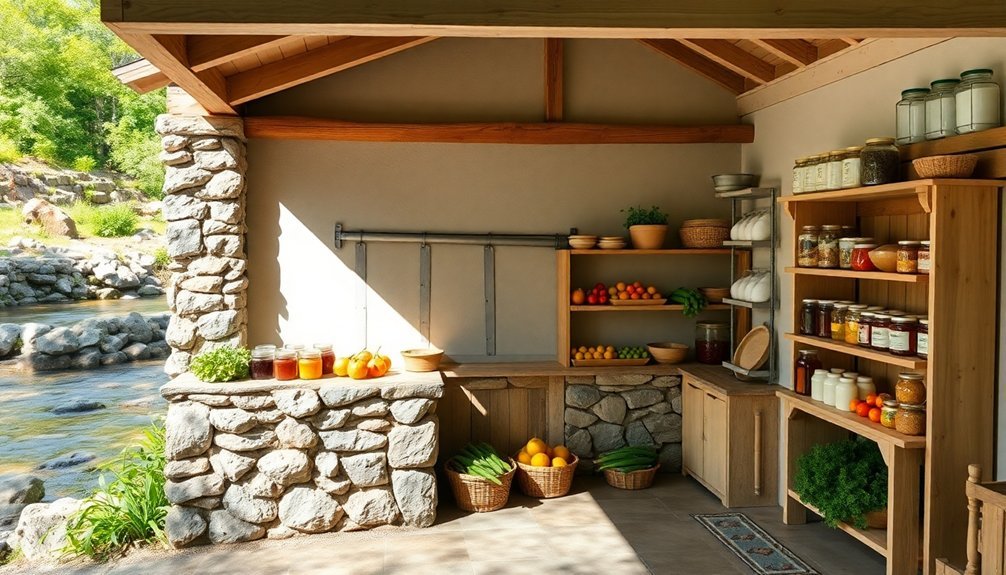
Modern families require four essential storage strategies when sharing living spaces: personal storage within units, common area solutions, secure lockers, and adaptable systems. When you're planning storage for multiple families, you'll need to take into account both individual and shared needs while maximizing available space.
- Optimize individual unit storage by installing behind-door shelving, utilizing under-bed storage, and incorporating vertical solutions like Baker's racks.
- Create common area storage zones in laundry rooms, fitness centers, and basements using modular lockers and FrameWRX shelving.
- Implement secure storage options that cater to different generations, ensuring easy access while maintaining privacy.
- Design flexible storage systems that can adapt to changing family needs and preferences.
You'll want to focus on making storage accessible and convenient for all residents. Think about installing narrow cabinets on door hinges for kitchens and bathrooms, and use mirrors with hidden storage to maximize vertical space.
Remember that over 62% of families prefer having additional storage options outside their living units, so incorporate secure lockers in common areas. This approach helps reduce the need for external self-storage units while maintaining an open, inviting living environment.
Choosing Your Spring House Size
Selecting the right spring house size depends heavily on your family's food storage needs and available water source.
You'll need to assess not just your current requirements but also potential future expansions of your storage capacity.
For basic needs, a small spring house with a single room and door might suffice. You'll have enough space for essential dairy storage and basic produce, though you'll be limited to one or two people working at a time.
If you're planning to make butter and cheese regularly, evaluate a medium-sized structure with a fireplace and second floor. This gives you dedicated space for dairy processing and drier storage above.
If you're storing food for multiple families or need space for various food processing activities, opt for a large spring house. You'll benefit from multiple rooms, separate areas for different tasks, and ample storage ledges.
Consider including a pool for large containers and a stream setup for additional functionality.
Remember that while larger sizes offer more flexibility, they also require more resources to build and maintain. Match your spring house size to your specific storage needs and available water supply.
Long Term Food Storage Options
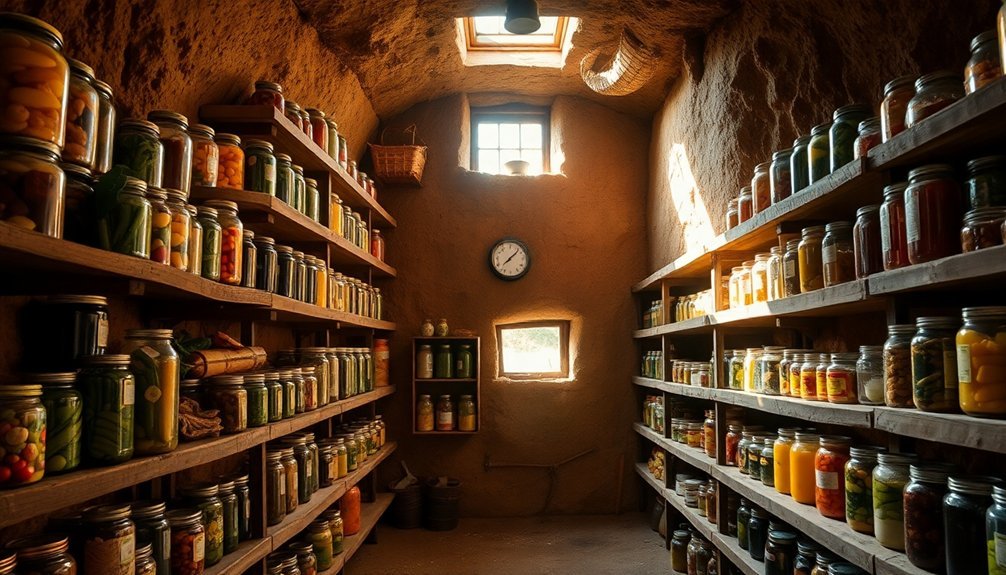
Inside a well-planned spring house, successful long-term food storage requires careful selection of both food items and storage containers.
You'll want to focus on foods with less than 10% moisture content, such as wheat, white rice, and dried beans. These items, when properly stored, can maintain their quality for extended periods.
For ideal storage, you'll need food-safe, opaque containers that seal completely. Five-gallon buckets are a cost-effective choice, while square buckets maximize space efficiency.
Make sure to use BPA-free, food-grade plastics to protect your supplies.
Here are the essential steps for maintaining your stored food:
- Break down bulk items into smaller, manageable portions
- Store food in cool, constant temperatures away from light
- Inspect your storage regularly for signs of moisture or pests
- Rotate your stock to maintain freshness
Plan for at least 12-18 months of shelf-stable food supply, considering your family's specific needs.
When storing in your spring house, take advantage of the natural cooling from water sources, but guarantee proper ventilation, especially for items like tobacco and garlic.
Keep your storage area clean and monitor for any signs of contamination.
Frequently Asked Questions
How Do You Protect a Spring House From Flooding During Heavy Rains?
You'll need to waterproof walls, install flood vents, use barriers like sandbags, guarantee proper drainage slopes, clean gutters regularly, and maintain sump pumps. Keep monitoring weather forecasts for advance flood warnings.
Can Modern Appliances Be Safely Installed Inside a Spring House?
You can install modern appliances in a spring house, but you'll need proper electrical wiring, moisture protection, and adequate ventilation. Consider space limitations and guarantee the structure can support the weight of your appliances.
What Wildlife Prevention Measures Should Be Taken for Spring House Safety?
You'll need to seal all entry points with steel mesh, install motion-activated lights, secure food storage containers, maintain a clean perimeter, and add chimney caps to prevent wildlife from accessing your spring house.
How Often Should Spring House Water Quality Be Tested?
You'll need to test your spring house water at least annually for bacteria, nitrates, and pH levels. Test more frequently if you notice changes in water quality or after repairs to the structure.
Are Permits Required for Building a Spring House on Private Property?
Yes, you'll need permits to build a spring house on private property. You must obtain necessary building permits from both county and town authorities, and comply with local zoning laws and regulations.
In Summary
You'll need to carefully match your spring house size to your family's specific food storage needs. For a single family, a 6×8 foot structure typically suffices for dairy products and vegetables. If you're planning for multiple families or long-term storage, consider a 10×12 foot or larger space. Remember, proper water flow and ventilation matter more than size alone for effective food preservation.

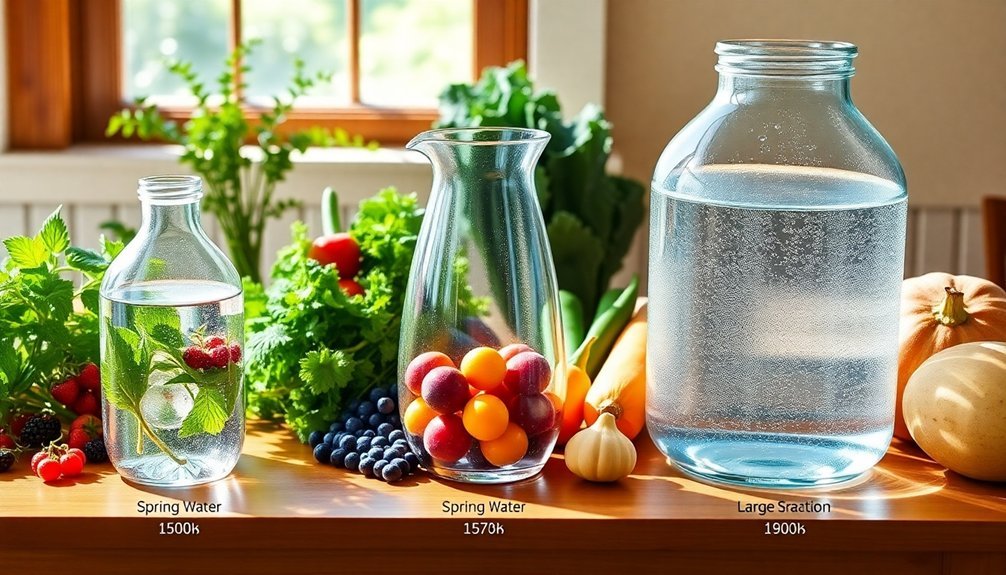



Leave a Reply